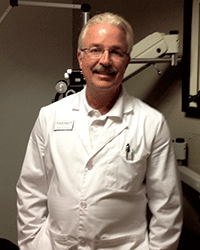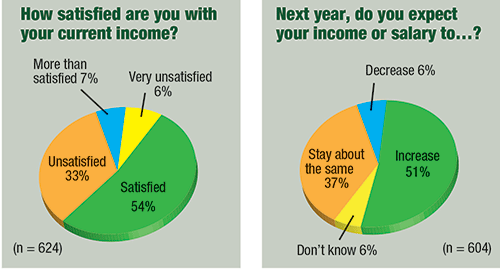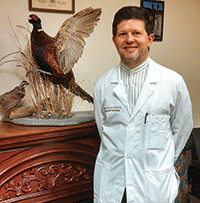Optometrists are working smarter, not harder—and actually earning more in the process. They’re adding associate doctors to spread the workload, and delegating to technicians to see more patients. They’re adopting the medical model while cutting back on low-paying vision plans.

| |
|
Steven M. Smith is one of many ODs who have increased their efficiency and
expanded their care without losing revenue. In many cases, they've gained new income.
|
“I’m working less, but making the same due to better medical model billing,” says Steven M. Smith, OD, of The Eye Care Clinic in Knoxville, Tenn.
Working smarter is finally paying off. Optometrists (particularly those who own a solo or group practice) are now earning more than ever. Of course, many doctors—especially newer ones—are still struggling with student loan debt while building up their practices.
These are some of the highlights of Review of Optometry’s latest annual Income Survey. The survey was emailed to more than 36,000 of our readers. Nearly 8,400 viewed the email and 881 optometrists responded.
Not-So-Average Income
Annual income for full-time optometrists (including both employed and self-employed ODs) averaged $148,220 in 2013, according to our survey. (This is your pre-tax income, not your net income, which is income after Uncle Sam takes his slice.)
Does this salary seem high for the average OD? For comparison, the Bureau of Labor Statistics estimates the US optometrist’s average annual wage to be $111,640, according to data released in May 2013. But buried in the Bureau’s fine print is that this estimate does not include self-employed workers, and doubtlessly many high-earning private practitioners are self-employed.
Thus, we feel that our survey’s findings reasonably and fairly reflect full-time US optometrists’ income.
Salary Specifics
Optometrists’ incomes vary by type of employment and years in practice, so measuring your income against the average may not tell you what you want to know. So, we break it down to give you a more accurate assessment of optometric income.
For instance, the average salary for optometrists who are employed (by another optometrist or MD, a commercial firm, an HMO or PPO, an optometry school or in other jobs) was $116,932 in 2013.
| Highlights of Review of Optometry's 2013 Income Survey | ||
| Average Income | $148,220 | (n=635) |
| Median Income | $117,000 | (n=635) |
|
|
||
| Average Income by Years in Practice |
|
|
| Less than 10 years | $109,341
|
(n=271)
|
| 11 to 20 years | $148,356
|
(n=106)
|
| 21 to 30 Years | $169,204 | (n=131) |
| More than 30 years | $201,359 | (n=106) |
| Self-employed ODs Average Income |
|
|
| All self-employed ODs | $179,438 | (n=319) |
| Solo practitioner | $168,304 | (n=171) |
| Partner/group practice | $235,943 | (n=87) |
| Independent contractor | $117,416 | (n=54) |
| Other | $184,909 | (n=11) |
| Employed ODs Average Income | ||
| All self-employed ODs | $116,932 | (n=313) |
| Other OD or MD | $112,469 | (n=183) |
| Commercial Firm | $118,553 | (n=51) |
| Academic institution | $120,508 | (n=19) |
| HMO/PPO | $154,846 | (n=13) |
| Hospital/VA center | $120,917 | (n=12) |
| Other | $125,058 | (n=19) |
| Average Gross Revenue — All ODs | $861,728 | (n=365) |
| Median Gross Revenue — All ODs | $680,000 | (n=365) |
|
|
||
| Self-employed ODs Average Gross Revenue | $798,724 | (n=264) |
| Self-employed ODs Median Gross Revenue | $658,000 | (n=264) |
| Employed ODs Average Gross Revenue | $1,026,411 | (n=101) |
| Employed ODs Median Gross Revenue | $750,000 | (n=101) |
ODs who own their own businesses fare better than employed optometrists. Self-employed ODs (whether in solo practice, partnership, group practice, franchises or those who work as independent contractors) had an average salary of $179,438.
Solo practitioners—the largest group among self-employed ODs—brought in a healthy average of $168,304, but partnership or group practice brings home an even bigger slice of bacon, with an average income of $235,943, according to our survey.
“Private practice is the way to prosperity in this industry,” says John E. Hilke, OD, of Hillsborough Vision Center, in Hillsborough, NJ.
Bear in mind that very high or very low individual salaries may skew the results in surveys such as this one. So, median income—the midpoint of all responses—may provide a better snapshot of the typical OD’s earnings. Median income for all optometrists was $117,000 in 2013. For self-employed ODs, it was $144,000, and $107,000 for employed ODs.

|
Another benchmark to consider is years in practice. As you might predict, highly experienced doctors earn more than newer docs. Specifically, ODs who’ve been in practice for more than 30 years averaged the most: $201,359. (Bear in mind that these are full-time optometrists, so semi-retired ODs in this bracket were not included.) ODs with 21 to 30 years of experience averaged $169,204, and those with 11 to 20 years averaged $148,356. Optometrists with less than 10 years’ experience earned an average of $109,341.
“Managing a business has to be learned. It hasn’t come naturally to me,” says Trisha Vance, OD, who has faced a steep learning curve in her first few years in practice at Vance Eye Care, in Chardon, Ohio. “Applying what I have learned, I am confident that my net percentage will grow in the coming years.”
Satisfied with Salary
This year’s survey finds that 61% of respondents say they are either “satisfied” (54%) or “more than satisfied” (7%) with their current income. Optometrists have a number of reasons for this, and here are just a few:

|
|
| "I've only been out in practice for a few years," says Amber Hurley, OD. "I feel like I am making enough to live on, pay loans and save a little. No complaints." |
• Family/life balance. “[It’s a] great profession to make a substantial living, but not sacrifice time away from your family,” says Brandon Mayes, OD, of Kid’s Eye Site in Oklahoma City, Okla.
• Job satisfaction. “I am blessed to do what I do to help people, as well as live comfortably,” says Richard Malara, OD, of Malara Eyecare & Eyewear Gallery, Baldwinsville, NY.
|
Gender Disparity in OD Income
In optometry, there is a gender gap in income. Actually, it’s more like a gulf than a gap. According to our survey results, male ODs earned an average of $174,408 in 2013 while female ODs averaged $109,892. That means men in optometry earned about 59% more than women in optometry! But hold on. There’s more to the story. Let’s look closely at these numbers because they are indeed skewed. Specifically, more younger female ODs and more older male ODs answered our survey. Because younger female ODs earn the least and older male ODs earn the most, we can attribute our survey response to skewing the average incomes for females and males. To account for this, we can look at income by years in practice (which is a reasonable, though not exact, approximation for age), and the gender gap tends to narrow—although it it doesn’t go away. For instance, among optometrists with fewer than 10 years in practice, women (n=149) earned an average of $96,758 while men (n=121) averaged $124,859, or a difference of 29% in men’s favor. Definitely not equal income but, as you would expect, the gap widens even further among the most experienced optometrists. Among ODs with more than 30 years in practice, women (n=9) had an average income of $141,213 while their male counterparts (n=100) averaged 46% more, with a mean of $206,643. Definitive reasons why male ODs earn more than female ODs (even when adjusted for age/experience level) are beyond the scope of this report. Reduced income due to time off for maternity leave and child care undoubtedly account for some of this difference, but most certainly not all. Still, the future looks promising for female ODs—optometry was recently ranked as one of the top US industries for women, according to IBISWorld, a market research firm. Phillips J. Top US Industries for Women. IBISWorld website. Aug 7, 2014. Available at: www.ibisworld.com/media/2014/08/07/top-us-industries-women. Accessed Oct 24, 2014. |
• Steady work, steady pay. “I’ve only been out in practice for a few years, and I feel like I am making enough to live on, pay loans and save a little,” says Amber Hurley, OD, of Envision Eye Care, Cedar Bluff, Va. “No complaints—I know that I will continue to grow and increase my income as the years go.”
• Fewer headaches. “Compared with other professions’ hours, stress and responsibilities, [we] have it easier,” says Neeraj Bindal, OD, of A Visual Affair in Arlington, Va. Indeed, optometry was found to be one of “15 High-Paying Jobs for People Who Don’t Like Stress,” according to an article that used data from the Bureau of Labor Statistics to rank “stress tolerance.”1
Much to be Desired
Not all optometrists see eye to eye on income satisfaction, of course. More than 33% of ODs say they are “unsatisfied” with their current incomes. Meanwhile, the number of ODs who report they are “very unsatisfied” has decreased to fewer than 6%—compared to a high of 9% in the depths of the recent recession. Here are just a few of their reasons for dissatisfaction:
• Heavy student debt. “With all the debt you incur during studies and all the time you spend treating patients, the income is not enough,” says Mark R. Quiñones, OD, of Texas Eye Health Consultants in Houston.
• Reduced insurance payments. “Reimbursement from insurers —especially vision care plans—continues to decline,” says Scott Krauchunas, OD, of Infocus Eyecare, Belmont, NH. “To generate more revenue, I need to see more patients to cover expenses.”
Clark Weeks OD, of Winfield, Ala., reports the same problem of trying to break even despite ever-declining managed care reimbursement fees: “I work twice as hard as I used to, just to make a similar income.”
• Increased expenses. “Based on cost of living/inflation, all of the concessions to insurance company fees and the continued expansion of managed care, it effectively has been like taking a gradual pay cut over the last 24 years of practice, while we continue to have more forced expenditures placed on us for things like EMR,” says Tom Tritschler, OD, of Eye Health Partners in Murfreesboro, Tenn.
Still, most ODs are hopeful for better days to come. Just over half (51%) anticipate their incomes will increase in 2014, while 37% hope it will at least stay the same. Fewer than 7% predict their incomes will decrease.

|
|
|
Increased expenses and decreased fees have amounted to a gradual pay cut, says Tom Tritschler, OD.
|
Optometrists have all sorts of ideas to increase their income, such as reducing overhead, working more hours, expanding medical eye care services, providing specialty products and services, dropping insurance plans, bringing on an associate or opening an additional office.
For his part, Dr. Tritschler laughs in the face of adversity. His plan: “Working toward possible supplemental income as an underwear model, and starting a cattle and swine herd.”
1. Giang V. 15 High-Paying Jobs For People Who Don’t Like Stress. Business Insider website. Nov 6, 2013. Available at: www.businessinsider.com/high-paying-jobs-for-people-who-dont-like-stress-2013-11. Accessed Oct 21, 2014.

